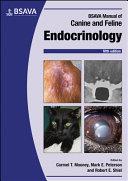BSAVA Manual of Canine and Feline Endocrinology V. edition

Od vydání třetího vydání v roce 2004 došlo k významnému pokroku v oblasti endokrinologie malých zvířat. Význam několika endokrinních poruch, jako je akromegalie koček a hyperaldosteronismus, vzrostl. Používání diety a nových preparátů u diabetických koček a nové léky, jako je trilostan a methimazol, které byly stručně zmíněny v předchozích vydáních, jsou nyní považovány za rutinu. Kromě toho byla objasněna genetická rizika spojená s mnoha poruchami.
Nová kapitola představuje principy interpretace výsledků endokrinních testů a pojednává o tom, jak je hodnocen výkon testu ve vztahu k diagnostické spolehlivosti. Informace o žlázách s vnitřní sekrecí a jejich onemocněních jsou prezentována ve standardním formátu – s podrobným popisem fyziologie, etiologie, klinických příznaků, diagnostiky a terapie je uspořádána tak, aby se usnadnilo vyhledávání informací.
Závěrečné části byly přepsány tak, aby se zaměřily na řešení klinických a klinicko-patologických endokrinologických abnormalit.
Autor: Carmel T. Mooney MVB MPhil PhD DipECVIM-CA MRCVS, Mark E. Peterson DVM DipACVIM
| Nakladatel | British Small Animal Veterinary Association |
|---|---|
| ISBN | 9781910443859 |
| Vydání | V. vydání 2023 |
| Vazba | brožovaná |
| Počet stran | 355 |
Since publication of the third edition in 2004 there have been important advances. Several endocrine disorders, such as feline acromegaly and hyperaldosteronism, have risen in importance. The use of diet and novel insulins in diabetic cats, and new drugs such as trilostane and methimazole, which were briefly mentioned in previous editions are now considered routine. In addition, the genetic risks associated with many disorders have been elucidated.
A new chapter presents the principles of interpreting endocrine test results and discusses how test performance is assessed in relation to diagnostic confidence.
The central section on glands and their diseases is presented in a standard format — detailing physiology, aetiology, clinical features, diagnosis and treatment - to aid information retrieval.
The final section has been rewritten to focus on solving clinical and clinicopathological abnormalities with an endocrine dimension.
About the Author
Carmel T. Mooney MVB MPhil PhD DipECVIM-CA MRCVS
Carmel is a University College Dublin graduate who spent several years in Scotland where she completed both MPhil (The University of Edinburgh) and PhD (The University of Glasgow) theses on feline hyperthyroidism. Following this she returned to UCD where she is currently Senior Lecturer in Small Animal Internal Medicine. Carmel obtained the European Diploma in Veterinary Internal Medicine (Companion Animals) in 1998 and is also an RCVS Recognized Specialist in Small Animal Medicine (Endocrinology), awarded in recognition of her clinical and research work. She is a Past President of the BSAVA (2005-2006) and was founding Secretary of the European Society of Veterinary Endocrinology.
Mark E. Peterson DVM DipACVIM
Mark graduated from the University of Minnesota in 1976, moved to NYC to do an internship and medical residency at The Animal Medical Center, and then completed a post-doctoral fellowship in endocrinology and nuclear medicine at The New York Hospital—Cornell Medical Center and the AMC, staying on there for over 30 years. In 2009 Mark opened the Animal Endocrine Clinic, a specialty referral hospital. Mark's clinical and research efforts have mainly been directed toward advancing the understanding of canine and feline endocrine disorders, especially diabetes mellitus and thyroid and adrenal disease. He has published more than 450 journal articles, book chapters and research abstracts, and is a frequent speaker at veterinary colleges and scientific seminars.
| Part I. Introduction of endocrine disease | 1 |
| Principles of endocrine disease | 1 |
| The genetics of endocrine disease | 6 |
| Hormone assays, quality control and sample collection | 13 |
| Principles of interpreting endocrine test results | 22 |
| Part II. Systemic effects of endocrine disease | 29 |
| The effects of endocrine disease on the cardiovascular system | 29 |
| The effects of endocrine disease on the renal system | 37 |
| The effects of endocrine disease on lipid metabolism | 44 |
| The effects of endocrine disease on the skin | 54 |
| Part III. Disorders of water homeostasis | 62 |
| Control of water balance and investigation of polyuria and polydypsia | 62 |
| Central diabetes insipidus | 71 |
| The syndrom of inappropriate antidiuresis | 79 |
| Part IV. Disorders of growth hormone | 82 |
| Pituitary dwarfism | 82 |
| Hypersomatotropismus | 89 |
| Part V. Disorders of calcium homeostasis | 97 |
| Control of calcium metabolism and investigation of hypo-and hypercalcaemia | 97 |
| Hypoparathyroidism | 108 |
| Hyperparathyroidism | 114 |
| Disorders of vitamin D metabolism | 122 |
| Part VI. Disorders of the thyroid gland | 128 |
| Canine hypothyroidism | 128 |
| Feline hyperthyroidism | 151 |
| Canine hyperthyroidism nad thyroid neoplasia | 169 |
| Feline hypothyroidism | 177 |
| Part VII. Disorders of glucose homeostasis | 185 |
| Control of glucose homeostasis and investigation of hypo- and hyperglycaemia | 185 |
| Canine diabetes mellitus | 193 |
| Feline diabetes mellitus | 209 |
| Investigation and management of unstable diabetcs | 227 |
| Diabetic ketoacidosis and hyperglycaemic hyperosmolar syndrome | 243 |
| Insulinoma | 252 |
| Part VIII. Disorders of the adrenal gland | 258 |
| Canine hypoadrenocorticism | 258 |
| Canine hyperadrenocorticism | 271 |
| Feline hyperadrenocorticism | 295 |
| Feline hypoadrenocorticism | 303 |
| Feline hyperaldosteronism | 309 |
| Phaeochromocytoma | 318 |
| The incidentally dicovered adrenal mass | 325 |
| Part IX. Unusual endocrine gland diseases | 331 |
| Concurrent endocrine neoplasia | 331 |
| Autoimmune polyendocrine syndromes | 336 |
| Erythropietin excess | 340 |
| Gastrointestinal tumors | 346 |
| Index | 350 |